Introduction
Losing hair can be frustrating. You notice strands piling up in the shower, on your pillow, or even on your desk at work. Suddenly, every mirror feels like an enemy. Sound familiar?
You’re not alone if you’ve tried hair oils, fancy shampoos, or weird home remedies (onion juice, anyone?) without luck. That’s where Best PRP Hair Treatment in Islamabad, Pakistan comes in. It’s a natural, non-surgical way to help your hair grow back stronger and healthier.
At Dr. Taskeen Iqbal’s clinic in Islamabad, people are seeing real results with PRP. But is it right for you? How does it work? Does it hurt? This guide answers all your questions—straightforward and honest.
What is PRP Hair Treatment?
PRP (Platelet-Rich Plasma) therapy is a simple but powerful way to help with hair thinning. Here’s the basic idea:
- A small amount of blood is drawn from your arm.
- It’s placed in a centrifuge, which spins fast to separate the platelet-rich plasma (the good stuff).
- Packed with growth factors, that plasma is injected into your scalp where hair is thinning.
These growth factors wake weak hair follicles, boost blood flow, and encourage stronger, healthier hair. Curious about affordability? Check out the Cost of PRP Hair Treatment in Islamabad: A Complete Guide to see how this natural solution fits into your budget. The best part? It’s natural—you’re just using your body’s healing powers.
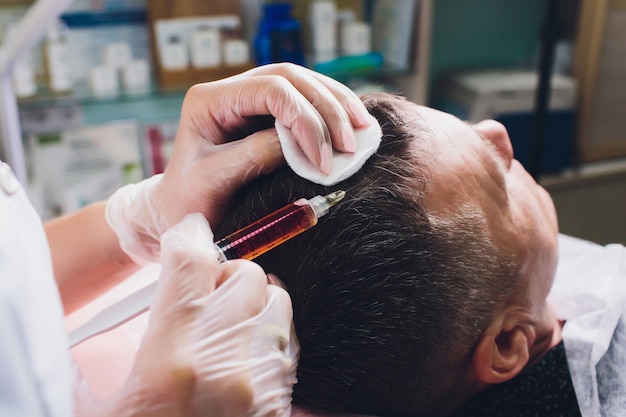
How Does PRP Hair Treatment Work?
PRP isn’t magic, but it’s backed by science. The growth factors in plasma help:
- Strengthen hair follicles so they stop shrinking.
- Reduce hair shedding (less hair in your brush = a win).
- Thicken existing hair, making it look fuller.
Think of it like fertiliser for your scalp—it helps hair grow better and healthier over time.
Who is a Good Candidate for PRP Hair Treatment?
PRP is best if you’re in the early stages of hair loss. It works well for:
- Men and women with thinning hair.
- Those with genetic hair loss (androgenetic alopecia).
- People recovering from a hair transplant.
- Anyone who wants a natural solution without medications or surgery.
On the other hand, if you have completely bald areas, PRP won’t bring those back to life. It works best when hair follicles are still active, and treatments like How PRP Treatment Boosts Hair Growth in Islamabad can explain why timing and follicle condition make a big difference. Also, if you have blood disorders or take blood thinners, you must check with your doctor first.
Each patient gets a personalised consultation at Dr. Taskeen Iqbal’s clinic to see if PRP is the right fit.
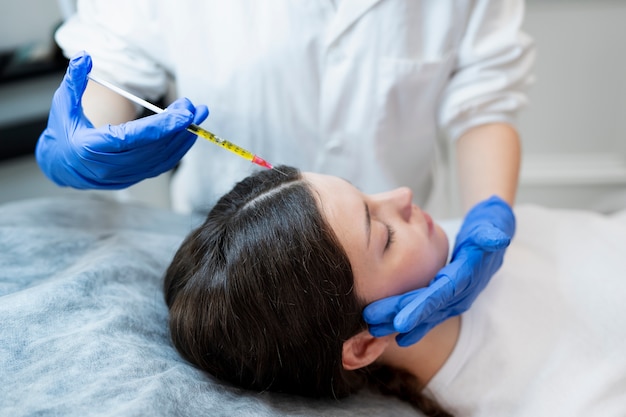
How Effective is PRP for Hair Loss?
PRP isn’t an instant fix, but it does work. Here’s what you can expect:
- First few weeks – Less hair shedding.
- Three to six months – Hair looks thicker and healthier.
- One year+ – Fuller hair with regular maintenance sessions.
It’s not a one-time cure, though. Think of PRP as hair maintenance—just like hitting the gym keeps your body in shape, regular PRP sessions help keep hair loss under control.
How Many PRP Sessions Are Required for Visible Results?
PRP isn’t a one-and-done deal. For the best results, most doctors recommend:
- Three to four sessions (each four to six weeks apart).
- Maintenance treatments every three to six months.
By the second or third session, you should see less shedding. Around the three-to-six-month mark, your hair will start looking thicker. And if you keep up with maintenance, those results will stick around.

Is PRP Hair Treatment Painful?
I’m not going to sugarcoat it—PRP involves needles, so it’s not completely painless. But most people say it’s mildly uncomfortable at worst.
- Some describe it as a tiny pinching sensation.
- A numbing cream is used to make it easier.
- The session takes about 30–45 minutes.
You’ll be fine if you can handle a waxing session or flu shot.
Are There Any Side Effects of PRP Hair Treatment?
Since PRP uses your blood, serious side effects are rare. The most common ones include:
- Mild redness or swelling (lasts a few hours).
- Scalp tenderness (feels like a mild sunburn).
- Tiny bruises at the injection sites (fade in a few days).
That’s about it. No major downtime no scary side effects. At Dr. Taskeen Iqbal’s clinic, PRP is done by experienced specialists, so you’re in safe hands.
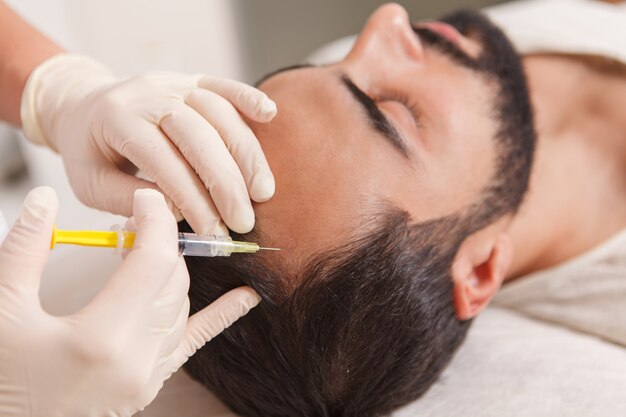
How Long Do PRP Hair Treatment Results Last?
Results don’t last forever, but you can keep your hair looking great for years with maintenance. On average:
- Results last 12 to 18 months before needing touch-ups.
- Lifestyle factors like stress, diet, and hair care affect how long results stick.
Think of PRP as getting your car serviced, skipping maintenance, and things starting to break down again.
PRP Hair Treatment vs. Other Hair Loss Solutions
How does PRP stack up against other treatments? Here’s the deal:
- Hair Transplants – Permanent but involve surgery and recovery time.
- Medications (Minoxidil, Finasteride) – Work well but must be taken daily (and can have side effects).
- Oils & Shampoos – Some help, but results are usually minimal.
PRP is a great middle-ground—natural, non-surgical, and works. Plus, it can be combined with other treatments for even better results.
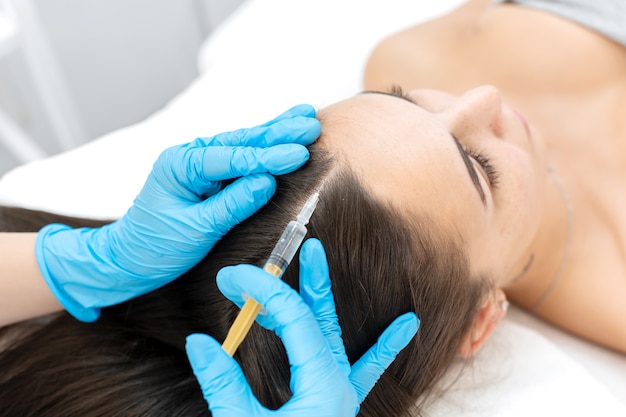
What is the Cost of PRP Hair Treatment in Islamabad, Pakistan?
PRP prices vary based on location and clinic. In Islamabad, expect to pay around PKR 12,000 – 20,000 per session.
Cheap PRP sessions might seem tempting, but be careful—quality matters. You want an expert handling your treatment, not just the lowest price. At Dr. Taskeen Iqbal’s clinic, PRP uses advanced techniques to achieve better results.
FAQs
Where to Get the Best PRP Hair Treatment in Islamabad?
If you’re looking for trusted PRP hair treatment in Islamabad, Dr. Taskeen Iqbal’s clinic is a top choice. You’re in good hands with years of experience, a personalised approach, and a focus on natural hair restoration.
Hair loss doesn’t have to be permanent. Take the first step—book a consultation today and start your journey to healthier, fuller hair.
What are the facts about PRP hair treatment?
PRP uses your own blood’s platelets to boost hair growth naturally. It’s non-surgical, safe, and works best for early-stage hair thinning. At Dr. Taskeen Iqbal’s clinic, PRP uses advanced techniques to achieve better results.
How do we maximise PRP results?
Stay consistent with your sessions and follow post-care guidelines for the best results. A healthy diet, scalp massages, and avoiding smoking can improve hair regrowth. At Dr. Taskeen Iqbal’s clinic, each patient gets a customised plan for long-lasting results.
What are the do’s and don’ts of PRP?
Stay hydrated, eat protein-rich foods, and avoid touching your scalp for a day. Don’t smoke, drink alcohol, or use harsh hair products for at least 48 hours. Dr. Taskeen Iqbal’s team provides detailed aftercare to help you get the best outcome.
What causes PRP to fail?
PRP may not work well if hair follicles are completely inactive or have an underlying health issue. Skipping sessions or ignoring post-treatment care can also affect results. That’s why Dr. Taskeen Iqbal’s clinic ensures a personalised approach for every patient.
If you’re looking for trusted PRP hair treatment in Islamabad, Dr. Taskeen Iqbal’s clinic is a top choice. You’re in good hands with years of experience, a personalised approach, and a focus on natural hair restoration.
Hair loss doesn’t have to be permanent. Take the first step—book a consultation today and start your journey to healthier, fuller hair.
PRP uses your own blood’s platelets to boost hair growth naturally. It’s non-surgical, safe, and works best for early-stage hair thinning. At Dr. Taskeen Iqbal’s clinic, PRP uses advanced techniques to achieve better results.
Stay consistent with your sessions and follow post-care guidelines for the best results. A healthy diet, scalp massages, and avoiding smoking can improve hair regrowth. At Dr. Taskeen Iqbal’s clinic, each patient gets a customised plan for long-lasting results.
Stay hydrated, eat protein-rich foods, and avoid touching your scalp for a day. Don’t smoke, drink alcohol, or use harsh hair products for at least 48 hours. Dr. Taskeen Iqbal’s team provides detailed aftercare to help you get the best outcome.
PRP may not work well if hair follicles are completely inactive or have an underlying health issue. Skipping sessions or ignoring post-treatment care can also affect results. That’s why Dr. Taskeen Iqbal’s clinic ensures a personalised approach for every patient.

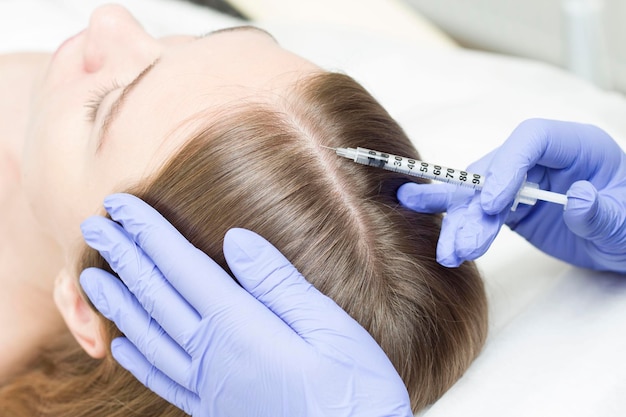
Leave a Reply